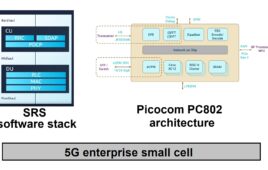Configurable silicon lets hardware run as a 4G/5G radio through to digital baseband at layer 3.
In Q3 2021, EdgeQ announced that it was developing a “base station on a chip” that uses software-configurable silicon for 4G and 5G macro cells and small cells. In June 2022, the company began demonstrating the technology at its Silicon Valley facility. 5G Technology World spoke with EdgeQ’s Adil Kidwai about the company’s progress.
EdgeQ’s recent announcement covers the silicon itself and a PCIe card containing two EdgeQ devices. The silicon appeals to designers designing macro cells and small cells. Use cases for EdgeQ’s silicon include routers, outdoor fixed internet-access points, and small cells. Applications range from private networks to datacenters. EdgeQ’s silicon uses software configuration as opposed to dedicated hardware. The silicon performs all functions of a base station from 5G and 4G radios to packet processing, scheduling, and beamforming. The silicon includes software from EdgeQ that lets it perform Layer-1 RF and baseband functions. L2/L3 stacks come from partners.
“The silicon is malleable and reformable,” said Kidwai. “It can function as macro cells and small cells; our hardware can do either.” The demo currently running operates as a 4×4 5G small cell connected to a 5G core network (Figure 1). In the demo, the silicon connects to a cell phone.
EdgeQ’s prime customers are cellular operators and owners of private networks. “We work with third-party OEM partners to develop the box but we work with the end user as well,” said Kidwai. For base-station designers, EdgeQ provides a reference design board. Over time, the company expects engineers to design other products around EdgeQ’s silicon, particularly for use in private networks that need specialized wireless access.
Engineers specify the features of the silicon at time of order. You get the full feature set but only those functions paid for are activated. The silicon is field upgradable with a software key. Thus, you can, for example, start with a 4G-capable device and upgrade to 5G later.
EdgeQ has also demonstrated its configurable silicon on a PCIe card. In that configuration, the card provides 2.2 Gb/sec Ethernet using eCPRI protocols for operating as an OpenRAN, O-RAN compliant radio unit (RU) and distribution unit (DU). Running inside a COTS PC, the card turns the PC into an O-RAN compliant RU server. The card also operates as an RU accelerator.
The PCIe card contains two EdgeQ chips. It’s configurable to run using any of the O-RAN functional splits, from Option 1 to Option 8 though most applications use Option 7.2. When running Option 1, the RU, DU, and centralized unit (CU) reside in a single chip. The radio within EdgeQ’s silicon can run at 256QAM over sub-6 GHz (FR1) frequencies.
When operating as a macro cell, the PCIe board functions as an RU accelerator running 4G and 5G physical layer (Figure 2). It then runs L2 software at 2.2 Gb/sec and an eCPRI interface at option 7.2. So, chip can be a small cell or anything through a DU server that’s O-RAN compliant.
The problem with software-configurable silicon,” said Kidwai, “is that it always uses more power than dedicated hardware. We broke that belief.” According to Kidwai, the EdgeQ silicon consumes less than 20 W of power.







Very good!